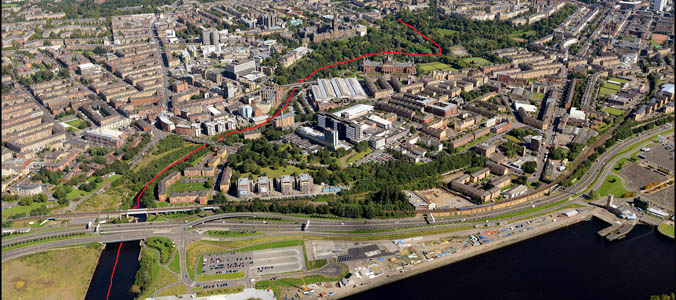UofG River Kelvin heating scheme gets 'go'
Published: 5 December 2014
The University of Glasgow has been successful in its bid for initial funding for a project to draw heat from the waters of the River Kelvin.
The University of Glasgow has been successful in its bid for funding for a project to draw heat from the waters of the River Kelvin.
 The news was announced by the Scottish Energy Minister, Fergus Ewing MSP at the end of last month.
The news was announced by the Scottish Energy Minister, Fergus Ewing MSP at the end of last month.
The University project was one of seventeen local energy projects from across Scotland awarded funding to support the development of green energy schemes.
More than 100 applications were received from community groups, charities, local authorities, housing associations, universities and businesses through the Community and Renewable Energy Scheme (CARES) Local Energy Challenge Fund. The successful applicants can use the funding to develop their ideas and proposals to take them to the next stage of the Challenge Fund with a deadline early in the new year.
The University scheme has the potential to reduce the heating bill by one quarter. It would be the first renewable energy scheme in Scotland to draw heat from a river.
Harvested
The technology, which has separately been pioneered by Glasgow firm Star Renewable Energy and has been successfully installed in lakes, rivers and estuaries in Scandinavia and Japan, would see a heat pump installed two metres below the surface of the Clyde or Kelvin rivers where latent heat from the sun keeps the temperature of the water between 8C and 10C all year round.
A small proportion of the river water would be fed through the pump where around two degrees of heat in the water would be harvested using heat exchangers and the cooler water would then be pumped back into the river.
Heat from the exchangers would be transferred to condensers which would boost the low-grade heat to 45C or higher using a process of reverse refrigeration. The resultant hot water would then be piped around 30 university buildings along with heat from other sources.
At the same time, initial work has been getting underway on the University's district heating scheme. This major infrastructure project will involve the replacement the network of heat pipes that runs between the largest buildings of the university's Gilmorehill campus. Gas-fired boilers are used to power the district heating system and they are also capable of generating electricity if required.
The main contractor for the UofG district heating scheme is Crown House Technologies. The company recently established their main site compound on a large part of the Boyd Orr building car park.

First published: 5 December 2014
<< December

